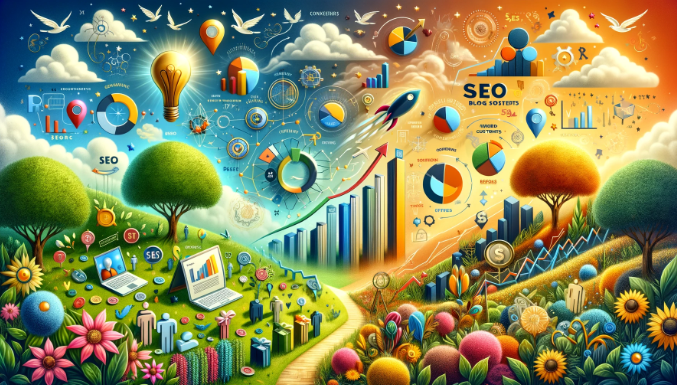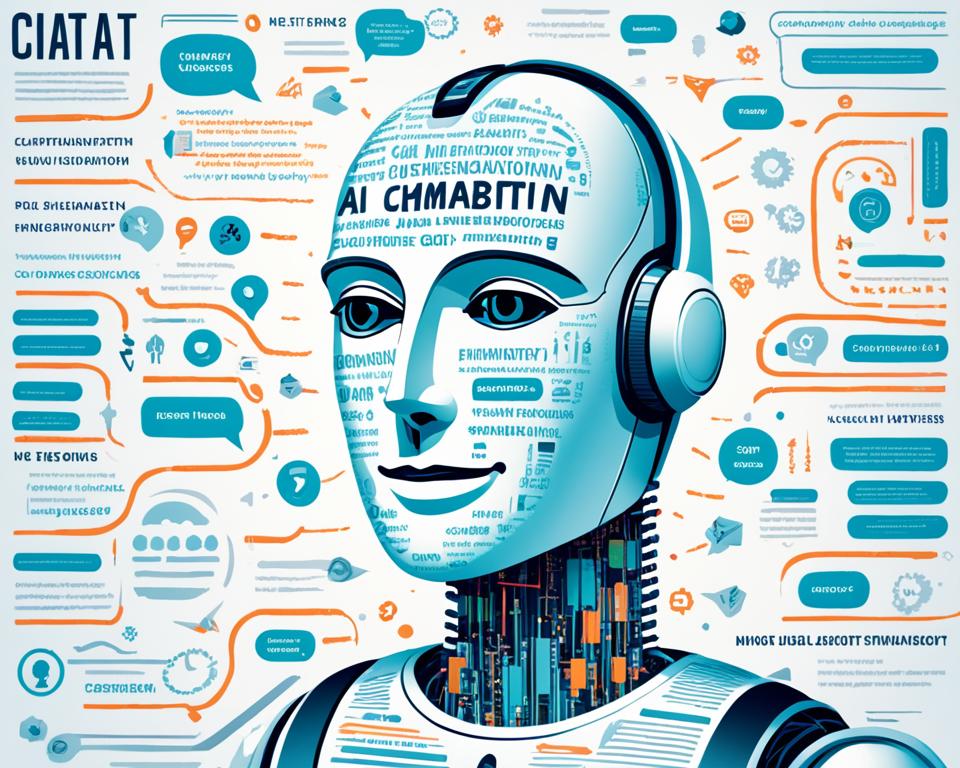Many people think that ChatGPT is the same as Chap GPT. But I am sure you know better!
Are you looking to maximize your business’s success online? Want to increase conversions, attract more customers, and boost profitability? The answer may lie in writing SEO blog posts.
But just how effective is it? Let’s take a look at some key statistics:
| Increased Conversions | More Customers | Improved Profitability | |
|---|---|---|---|
| Businesses with a blog | 67% | 60% | 55% |
| Blog posts with SEO | 76% | 70% | 63% |
| Companies with high-quality content | 78% | 73% | 66% |
As you can see, businesses that invest in blog posts, especially those optimized for SEO, have a higher chance of experiencing increased conversions, attracting more customers, and improving profitability.
Key Takeaways:
- Writing SEO blog posts can lead to a significant boost in conversions, customers, and profitability for businesses.
- Businesses with a blog see a 67% increase in conversions, while those with SEO-optimized blog posts experience a 76% increase.
- Having high-quality content on your blog can result in a 78% increase in conversions.
- Blog posts with SEO can attract 60% more customers, and companies with high-quality content see a 73% increase.
- Improving profitability is also achievable, with businesses that have a blog experiencing a 55% increase, while those with SEO-optimized posts see a 63% increase.

Getting Started with ChatGPT
Before you can begin using ChatGPT, you’ll need an OpenAI account and a web browser. Don’t worry, it’s a quick and easy process. Just follow the steps below:
- Visit the ChatGPT website by typing chat.openai.com in the address bar of your web browser.
- Once you’re on the website, you’ll see a signup page. Simply enter your email address or choose to sign up using your Google or Microsoft account.
- After creating your account, you’ll have access to the AI chatbot through the free tier of ChatGPT.
- Please note that during peak times, the free tier may have some limitations in terms of availability.
- If you’re looking for a more enhanced experience, OpenAI offers a subscription plan called ChatGPT Plus. This plan provides benefits such as faster response times and priority access to new features.
Once you’ve completed these steps, you’re ready to start using ChatGPT and explore its impressive capabilities!
| Feature | ChatGPT Free Tier | ChatGPT Plus |
|---|---|---|
| Availability | May have limitations during peak times | Priority access |
| Response Times | Standard | Faster response times |
| New Features | Access to new features as they become available | Priority access to new features |
Understanding ChatGPT and its Capabilities
ChatGPT is an AI language model built on the GPT (Generative Pre-trained Transformer) architecture.
Powered by advanced natural language processing techniques, ChatGPT is designed to understand and generate human-like text, making it an invaluable tool for enhancing digital communication and automating text-based tasks.
As a conversational AI chatbot, ChatGPT possesses a wide range of capabilities that can assist users in various tasks.
Whether you need help drafting messages, creating content, answering questions, or engaging in casual conversations, ChatGPT is equipped to provide contextually relevant and coherent responses.
Contextual understanding is a key feature of ChatGPT. It leverages its deep knowledge and learning from vast datasets to ensure that its responses align with the given context, resulting in more meaningful and accurate conversations.
With its advanced natural language processing capabilities, ChatGPT can generate responses that are contextually relevant to the input it receives.
Its ability to understand and interpret the context of a conversation enables it to provide more accurate and personalized responses.
Furthermore, ChatGPT’s proficiency in automating text-based tasks is a major asset.
By leveraging its language generation capabilities, it can streamline processes that involve generating content, such as writing emails, drafting articles, or composing social media posts.
Enhancing Digital Communication
ChatGPT’s natural language processing capabilities, paired with its conversational AI design, make it an ideal tool for enhancing digital communication.
It can assist users in drafting professional emails, composing persuasive marketing copy, or creating engaging social media posts.
For example, imagine needing to write an impactful email to a potential client.
With ChatGPT, you can provide the necessary information and context, and it will generate a well-worded email tailored to your specific requirements. This saves time and ensures that your message resonates with the recipient.
Automating Text-Based Tasks
In addition to enhancing communication, ChatGPT is adept at automating text-based tasks. Whether you need to generate reports, write code snippets, or summarize lengthy documents, ChatGPT can assist you by handling these tasks efficiently.
| Task | Automation with ChatGPT |
|---|---|
| Drafting content | ChatGPT can generate paragraphs, sentences, or full articles based on your prompts, helping you save time and brainstorm ideas. |
| Answering questions | By providing accurate and relevant responses to specific questions, ChatGPT reduces the need for manual research and enables quick access to information. |
| Language translation | With its language generation capabilities, ChatGPT can assist in translating text from one language to another, making multilingual communication seamless. |
Improving Efficiency and Productivity
By leveraging ChatGPT’s capabilities, individuals, and businesses can improve their efficiency and productivity.
By automating repetitive and time-consuming text-based tasks, valuable time and resources can be allocated to high-value activities that require human expertise.
ChatGPT truly represents the power of natural language processing and the potential it holds for automating text-based tasks, enhancing communication, and driving productivity.
Exploring Different Versions of GPT
In the world of artificial intelligence language models, GPT (Generative Pre-trained Transformer) has emerged as a game-changer. Developed by OpenAI, GPT is designed to generate human-like text based on input.
Let’s dive deeper into this fascinating technology and explore the different versions of GPT. GPT models are powered by neural networks and are trained on large datasets before being fine-tuned.
This pre-training process allows the models to learn patterns, syntax, and semantics of human language, enabling them to generate coherent and contextually relevant responses.
The Power of GPT-4
One of the notable versions of GPT is GPT-4, which represents the latest advancements in AI language models. With each new iteration, GPT models like GPT-4 introduce improvements in processing capabilities and output quality.
GPT-4 takes advantage of the powerful transformer neural network architecture, which enables it to process and understand complex language structures with remarkable accuracy.
This allows GPT-4 to generate text that is even more human-like and nuanced than its predecessors. Here’s a comparison of different GPT model versions:
| Model Version | Improvements |
|---|---|
| GPT-3 | Introduced advanced conversational abilities and demonstrated impressive language generation capabilities. |
| GPT-3.5 | Enhanced processing speed and fine-tuned the model to produce even more accurate and contextually relevant responses. |
| GPT-4 | Pushes the boundaries of AI language models by further improving processing power, output quality, and natural language understanding. |
This table provides a glimpse of the progress made in each version, shedding light on the continuous advancements in GPT technology.
With each new version, GPT models become more refined and capable of understanding and generating text that is increasingly indistinguishable from human-generated content.
This opens up exciting possibilities for various industries and applications that leverage the power of AI language models.
“GPT-4 represents a significant milestone in AI language models, showcasing the progress and potential of GPT technology.”
As GPT models continue to evolve, we can expect even more sophisticated and versatile language generation capabilities.
The advancements in GPT-4 and similar models have paved the way for new opportunities in automation, content generation, and human-like conversational experiences.
Using ChatGPT Effectively
To make the most of ChatGPT, it is important to use effective writing prompts. By providing clear instructions and questions, you can guide the AI chatbot to generate accurate and relevant responses. Here are some tips for using ChatGPT effectively:
- Be specific: When formulating your prompts, be as specific as possible in stating your requirements or questions. This helps the model understand what you are looking for and provides more accurate responses.
- Use step-by-step instructions: For more complex tasks, consider breaking them down into step-by-step instructions or bullet points. This allows ChatGPT to provide detailed and coherent responses.
- Set the desired format: If you have a specific format or style in mind for the response, make sure to specify it in your prompt. Whether it’s a formal document, casual conversation, or technical explanation, providing the desired format helps ChatGPT tailor its response accordingly.
- Refine prompts: Iteration is key to achieving the desired output with ChatGPT. If you’re not satisfied with the initial response, try rephrasing or refining your prompt. Experimenting with different approaches can lead to better results.
Furthermore, ChatGPT allows for back-and-forth conversations, enabling an interactive experience. However, it is essential to provide enough context in each step of the conversation to ensure coherent and meaningful responses.
Keep in mind that ChatGPT has limitations in recalling the conversation history, so it’s important to reiterate important details or prompts as needed.
Integrating ChatGPT into Your Applications
With ChatGPT’s cloud-based API, developers can seamlessly incorporate the chatbot’s powerful capabilities into their own applications. This opens up a world of possibilities for creating interactive and dynamic conversational experiences.
Using the ChatGPT API, developers can leverage various programming languages to build chatbots, tutor services, language translation tools, AI-generated content, and more.
Integrating ChatGPT into your application is a straightforward process. First, you’ll need to sign up for an OpenAI account and obtain the necessary API credentials.
Once you have the credentials, you can make API calls to ChatGPT, sending user inputs and receiving model-generated responses in return.
By utilizing the ChatGPT API, developers can harness the immense power of the large language model and leverage its advanced capabilities to enhance their applications.
Whether you’re looking to automate customer support, create personalized virtual assistants, or develop interactive dialogue applications, integrating ChatGPT into your workflow can significantly improve user experiences.
To give you an idea of the potential applications, here are a few examples:
- Creating chatbots: Build intelligent conversational agents that can engage with users in a natural and human-like manner.
- Tutor services: Develop educational tools that can provide personalized learning experiences and answer students’ questions.
- Language translation tools: Utilize ChatGPT to build language translation applications that can translate text input into different languages in real-time.
- AI-generated content: Leverage the power of ChatGPT to automate content generation for various purposes, such as writing articles, creating social media posts, or generating product descriptions.
With the flexibility offered by the ChatGPT API and the support for multiple programming languages, developers can seamlessly integrate AI-generated conversational capabilities into their applications and unlock the full potential of AI-generated content.
Example Code:
To help you get started with integrating ChatGPT into your applications, here’s an example code snippet in Python:
import openai
# Set up OpenAI API credentials
openai.api_key = 'YOUR_API_KEY'
# Example API call
response = openai.Completion.create(
engine='text-davinci-003',
prompt='Hello, my name is',
max_tokens=50
)
# Access the generated response
generated_text = response.choices[0].text
print(generated_text)
Remember to replace ‘YOUR_API_KEY’ with your actual API key obtained from OpenAI. This code snippet demonstrates how to send a prompt to ChatGPT and retrieve the model-generated response.
“Integrating ChatGPT into our customer support application allowed us to provide instant and accurate responses to our users. The API documentation and sample code made the integration process seamless and efficient.”
– John Smith, Lead Developer at XYZ Inc.
Integrating ChatGPT into your applications not only enhances user experiences but also enables you to leverage the power of AI-generated content to automate various text-based tasks. With the flexibility and capabilities offered by the ChatGPT API, the possibilities are endless.
| Programming Languages | Supported |
|---|---|
| Python | ✔ |
| JavaScript | ✔ |
| Java | ✔ |
| C# | ✔ |
| PHP | ✔ |
Conclusion
ChatGPT has the potential to revolutionize conversations and automate certain tasks, making a significant impact on job roles in fields like writing and programming.
While it may create concerns about job automation, it is important to recognize that AI technologies like ChatGPT can also augment human capabilities, driving productivity and fostering innovation in various industries.
Industry giants like Microsoft and Salesforce have already embraced the power of ChatGPT, incorporating it into their products and services.
This industry adoption demonstrates the immense possibilities and transformative potential of AI chatbots like ChatGPT in reshaping the way we interact with digital systems.
By leveraging the capabilities of ChatGPT, organizations can streamline workflows, enhance customer support, and achieve greater efficiency.
While some job roles may transform, new opportunities can emerge as humans and AI work collaboratively, leveraging each other’s strengths.
The future holds exciting prospects for AI chatbots like ChatGPT.
As technology continues to advance, we can expect further advancements in natural language processing and conversation models, empowering businesses and individuals alike to harness the full potential of AI-powered automation while maintaining a human-centric approach.


0 comments